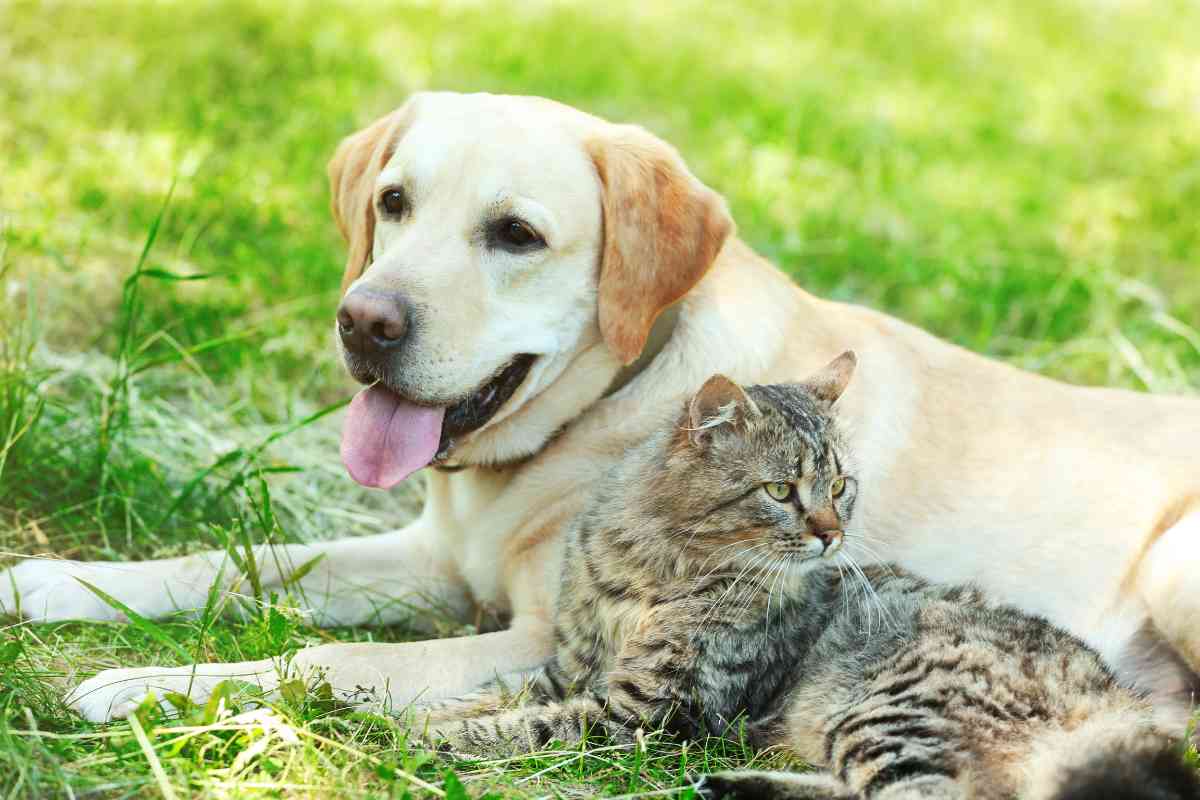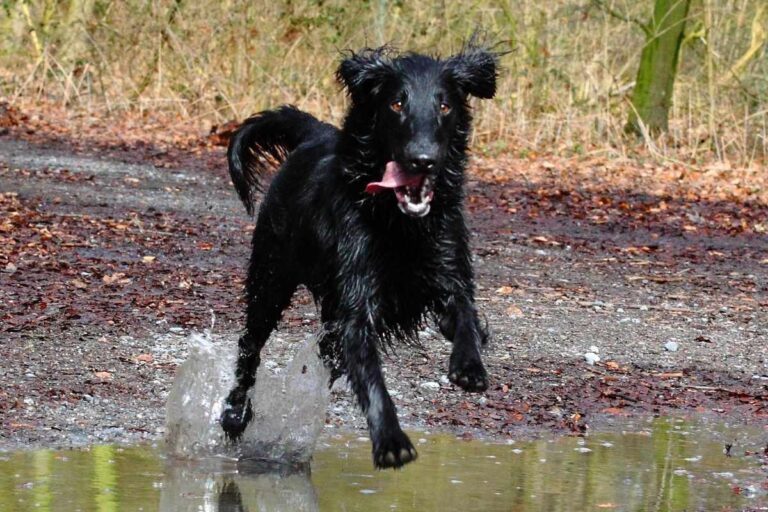Labrador Retrievers & Cats: The Ultimate Guide To A Peaceful Kingdom
Dogs and cats have a well-established reputation as antagonists. But are Labrador Retrievers good with cats?

Are Labradors Good With Cats?
Labrador Retrievers are good with cats. Their disposition and traits make them good companions for cats. Additionally, their social nature makes them want to seek out new friends. Cats are energy balls, and Labradors are likely to respond with the same energy instead of being terrified.
Being a Labrador Retriever owner for more than ten years and a proud owner of two grown cats, I always feared having a hostile pet household. Thankfully, my fears were put to rest after a few months, as these pets were getting along well.
Keeping Labradors And Cats Together

Every pet lover’s joy is seeing their pets build a smooth friendship. Labrador Retrievers are no exception, as they can live harmoniously with cats.
How you introduce them to each other matters greatly. The Labrador Retriever, however, is a lover and not an opponent.
Labradors are not territorial regarding other pets; hence they are adorable. The key to a smooth friendship between these two pets is understanding how to address their concurrency.
American Labradors, known for their working background, stay lively and active throughout their lives. They are outgoing and sociable; hence likely to get along with felines with the same energy level.
Unlike American Labradors, English Labs take longer to attain maturity. Therefore, they take longer to outgrow their puppyhood disposition.
These labs have a sedentary personality and often display a more chill character. Their traits, however, do not prevent them from getting along with cats. They equally live harmoniously with cats,
Below are reasons why most Labrador Retrievers get along with cats:
Affectionate and Friendly
Labradors are naturally friendly. These dogs’ disposition makes them want to seek and make new friends whenever possible.
These dogs love to be the center of attention and are always eager to please their owners. Labs are likely to approach cats and make friends due to their friendly nature.
High Trainability
Labrador Retrievers rate highly on the trainability scale because they are intelligent dogs. As a Labrador owner, you do not have to teach them commands more than five times as they are fast learners.
You can easily teach them how to control their chase instincts which running cats sometimes trigger. Labradors’ ability to learn fast leads to a more peaceful existence with cats.
Labradors are not Territorial
The fact that Labrador Retrievers are not territorial is another trait that makes it easy for them to live with cats harmoniously. Labrador Retrievers do not have an issue with sharing their space with cats.
These dogs are not protective over food; hence they can never be archenemies with cats. Eventually, sharing space with other pets makes Labradors happy as they are social dogs.
They are not Aggressive
Since Labradors are intelligent dogs, they can easily distinguish between an attack and rough play. Therefore, it is hard for them to attack cats even when fighting.
While cats’ playful nature easily provokes other dogs, Labradors’ temperament makes the situation safe.
Are Labrador Retrievers Good with Kittens?

As mentioned earlier, Labradors are friendly pets. Therefore, introducing a kitten when Labs are already established in the household is not an issue.
Kittens are energetic, and at that tender age, they probably have not learnt to fear dogs. This makes their co-existence with Labradors smoother as they do not feel intimidated by the dogs.
Labradors are likely to respond well to kittens due to their friendly disposition. Female Labradors love to take mothering roles on younger kittens.
Labradors will never see kittens as threats as they are not startled by the kittens’ playfulness. They embrace the kittens and live with them harmoniously even when they are older.
The Best Time to Introduce Cats to Labrador Retrievers
Timing is an essential factor when it comes to introducing Labrador Retrievers to cats. Age does not feature as a factor, as it is possible to present any age Labrador to any age cat.
However, introducing an older cat to a Labrador puppy or introducing a more senior Labrador to kittens is likely to bear tremendous success.
Although it may seem weird, Labrador puppies get along well with older cats. Puppies have tons of energy, but it is never a stress factor for older cats. Their tender age makes it easy for them to adapt and learn how to live with cats.
If possible, the best time to introduce Labradors to cats is when they are both young. At their tender age, these pets are more likely to get along as they both crave the company of their littermates.
When you introduce these pets to each other while they are young, they grow accustomed to each other’s presence. Since they will grow up together, neither is predisposed to show possessive behaviors.
Introducing Labs to cats can either be a success or a failure depending on how and when you choose to do it.
How to Introduce a Cat to a Labrador Retriever
How you introduce a cat to your Labrador Retriever determines whether or not they will get accustomed to each other’s presence. A successful introduction leads to a better foundation for mutual friendship.
Before bringing in a cat, your Labrador should be responsive to basic commands like ‘sit’ and ‘off.’ This way, you are sure that you can control your dog. You do not simply go to your Lab’s domain and toss in a cat, as it may turn out dangerous.
Based on the age and other factors, there are different methods that you can use to introduce cats to Labrador Retrievers successfully.
Crate and Leash Method
This method offers the cat the advantage of viewing the world from a high point. You will need a table, a crate, and a leash. Always ensure that your dog is calm when carrying out the tabletop method.
- Put your dog in the crate. Place your cat on top of the table where it can see the dog. Offer treats to both your pets as they watch each other. During this period, you can observe if one pet is agitated.
- Place the cat on the table once more if your pets are comfortable in each other’s presence. Leash your Labrador and bring them in. Have the dog sit and give both pets treats. If they are both calm, gradually bring the Lab to the table. Have them close to each other for some time and observe their reactions.
- This step calls for you to unleash your Labrador. Observe any perceived aggression from both pets. Repeat the second step if this step does not go well until both pets are relaxed.
- Once you’ve had several successful off-leash sessions, you must leave the pets to interact without your supervision. Ensure the cat has an escape in case the Labrador becomes aggressive. Repeat these sessions until the pets can stand each other fondly.
The Dinner Method
This method involves four steps that create a positive association between your Labrador and your new feline.
- Set up your cat’s space and spend time with it. With time, your new cat should get used to you.
- Set up the Labrador’s and cat’s food on opposite sides in an isolation room. Bring in the cat in a crate and the dog on a leash. The smell of food should excite both pets. If the dog begins to act out, correct them by redirecting them back to eating.
- Ensure that the sessions are short and gradual until they work together.
- Let the cat loose in the room and retain the Lab on a leash as the cat explores the room. If the Labrador acts agitated, correct them verbally. If they stay calm, offer them treats. After several successful interactions, both pets will be ready to get along unsupervised.
Precautions to Take When Introducing Cats to Labrador Retrievers
Always note that even the most friendly Labradors can sometimes become startled and act aggressively. For this reason, it is vital to take precautions when introducing these pets to each other. Below are precautions that you should follow.
- Ensure that the cat is comfortable and safe. The slightest agitation can make a cat uncomfortable, and it will try to flee. Therefore, when introducing them to Labradors, ensure they have an escape route.
- Avoid carrying out introductions around children. Young children can be the cause of anxiety during introductions. Children may also end up injured may the Labrador decide to take out their aggression on them.
- Be sure to leash your Labrador during the first sessions.
- Keep the sessions short and gradual.
- Ensure that the introduction room is neutral for both pets.
Key Takeaways
- Labrador Retrievers make great companions. Their traits and disposition make them good companions for cats.
- While some Labradors become fast friends with cats, others take time to get used to each other. Be patient with the introduction for successful results.
- At least 95% of the time, Labradors constantly learn new commands less than five times. Therefore, training them on how to live with cats is relatively straightforward.
- It is possible to introduce any age cat to any age Labrador Retriever.
- Labrador Retrievers are intelligent dogs that learn new commands in less than five tries. Therefore, training them to get along with cats is not challenging.






